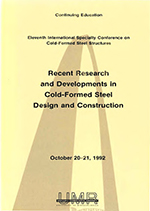Location
Saint Louis, Missouri
Session Dates
20 Oct 1992
Abstract
The American Iron and Steel Institute's Specification for the Design of Cold-Formed Steel Structural Members (1) presently requires that channel and zee flexural members, when not attached to sheathing, be braced against twist and lateral translation at the quarter-points of the span (Section D3.2.2). This provision first appeared in the Second Edition of the Specification in 1956, and has been there through all succeeding editions up through the 1989 Addendum. The newest formula for lateral buckling (part (a) of C3.1.2) is a more exact procedure for calculating lateral torsional buckling of a doubly, singly, or point symmetrical section than was the earlier one (now part (b)). It is fair to ask, then, whether the requirement for quarter-point bracing is still needed. If a user wishes to space lateral braces at greater distances and accept a reduced bending capacity, why should quarter-point braces be mandated? Was the original reason for including this provision in the 1956 Specification more a serviceability consideration than strength? The purpose of this research was to find answers to these questions.
Department(s)
Civil, Architectural and Environmental Engineering
Research Center/Lab(s)
Wei-Wen Yu Center for Cold-Formed Steel Structures
Meeting Name
11th International Specialty Conference on Cold-Formed Steel Structures
Publisher
University of Missouri--Rolla
Document Version
Final Version
Rights
© 1992 University of Missouri--Rolla, All rights reserved.
Document Type
Article - Conference proceedings
File Type
text
Language
English
Recommended Citation
Sputo, Thomas; Haynes, Jack; and Ellifritt, Duane S., "Flexural Capacity of Discretely Braced C's and Z's" (1992). CCFSS Proceedings of International Specialty Conference on Cold-Formed Steel Structures (1971 - 2018). 2.
https://scholarsmine.mst.edu/isccss/11iccfss/11iccfss-session3/2
Flexural Capacity of Discretely Braced C's and Z's
Saint Louis, Missouri
The American Iron and Steel Institute's Specification for the Design of Cold-Formed Steel Structural Members (1) presently requires that channel and zee flexural members, when not attached to sheathing, be braced against twist and lateral translation at the quarter-points of the span (Section D3.2.2). This provision first appeared in the Second Edition of the Specification in 1956, and has been there through all succeeding editions up through the 1989 Addendum. The newest formula for lateral buckling (part (a) of C3.1.2) is a more exact procedure for calculating lateral torsional buckling of a doubly, singly, or point symmetrical section than was the earlier one (now part (b)). It is fair to ask, then, whether the requirement for quarter-point bracing is still needed. If a user wishes to space lateral braces at greater distances and accept a reduced bending capacity, why should quarter-point braces be mandated? Was the original reason for including this provision in the 1956 Specification more a serviceability consideration than strength? The purpose of this research was to find answers to these questions.



